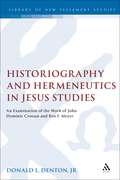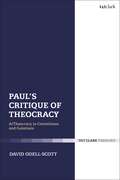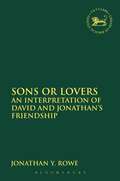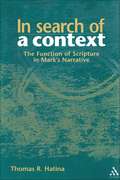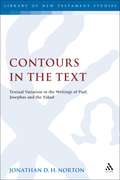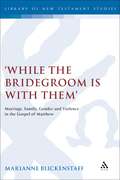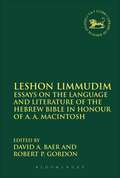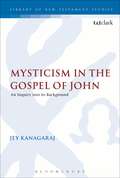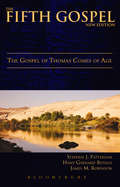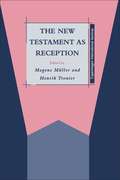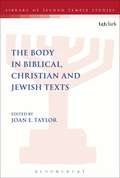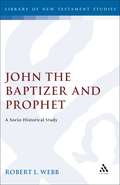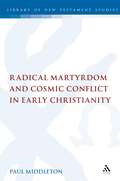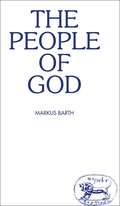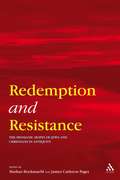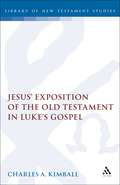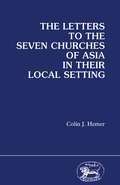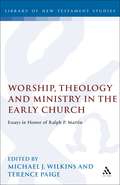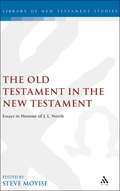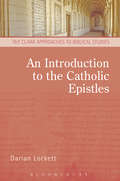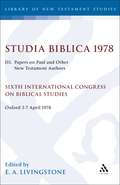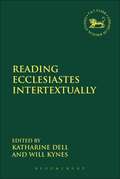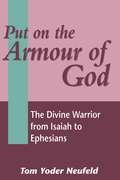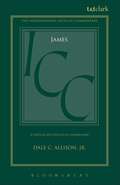- Table View
- List View
Historiography and Hermeneutics in Jesus Studies: An Examinaiton of the Work of John Dominic Crossan and Ben F. Meyer (The Library of New Testament Studies #262)
by Donald L. DentonThis work identifies two distinct methodological approaches in Jesus studies, as represented by the work of two prominent historical Jesus scholars, Dominic Crossan and Ben Meyer. Crossan's work is the apotheosis of a venerable approach centered on "tradition criticism." Meyer offered a critique of this approach in the form of a historiographic "holism." This work brings Meyer's proposals to light in a sharp comparison with the historiographic assumptions he criticized. It goes beyond Meyer, recognizing the full significance of narrativity in historical method.
Paul's Critique of Theocracy: A Theocracy in Corinthians and Galatians (The Library of New Testament Studies #250)
by David Odell-ScottPaul's Critique of Theocracy offers an interpretation of select texts in Corinthians and Galatians concerned with the establishment of legitimate authority in the Christian community. Odell-Scott argues that for Paul, no one may boast that they are selected by God, and no one has the authority to rule as God's representative. Paul also criticizes those who exhibit a superior "sacredness" over other community members. Contrary to most scholarly views, Odell-Scott argues that Paul is not taking sides in a debate about the proper authority structure. Rather, he criticizes any notion of such a structure, opposing it with his metaphor of the Church as the body of Christ and the "sacred family" of God. The exegesis is also sketched out in a postmodern framework criticizing hierarchy through differentiation.
Sons or Lovers: An Interpretation of David and Jonathan's Friendship
by Jonathan Y. RoweJonathan Rowe examines David and Jonathan's friendship in the context of what ancient readers would have understood as the 'natural' loyalty to their families. He focuses on the conflicting moral goods between which the men choose, seeking to understand the dynamics of the narrative consonant with ancient society. Rowe discusses theoretical issues of interpretation and summarises how Bakhtin's theory of heteroglossic voices can be utilised to understand the narrative. He deliberates over the key aspects of family life in the world described by the Old Testament, surveys approaches to the study of the family among anthropologists and, finally, states how anthropology can inform the interpretation of the biblical text. Starting from the concept of 'hegemonic masculinity', Rowe examines how men in general are presented positively, and then shows how Jonathan, David and Saul measure up to these standards. Rowe concludes that although Jonathan was disloyal to his family, something that implied readers would have censured, the books of Samuel present this disloyalty as honourable, thus making a theological point about fidelity to the house of David.
In Search of a Context: The Function of Scripture in Mark's Narrative (The Library of New Testament Studies #232)
by Thomas R. HatinaIn this book the author explores how contexts determine the meaning of embedded scripture texts in the Gospel of Mark. Many historical critics base their readings on a context that is external to MarkÆs story world, be it a reconstructed socio-religious setting of the evangelist, a Jewish exegetical tradition or some earlier stage in the development of the gospel. What is common to these readings is the neglect for the context of the story world- the very context in which scripture quotations and allusions are embedded. The author proposes a method of reading these embedded texts that is sensitive to the story world, though not at the expense of the historical setting in which the gospel was written. Jesus' announcement in 1:15 concerning the kingdom of God serves as the point of entrance into Mark's story world.
Contours in the Text: Textual Variation in the Writings of Paul, Josephus and the Yahad (The Library of New Testament Studies)
by Jonathan D.H. NortonThis is an examination of Paul's possible awareness of the plurality of Ancient Jewish Scripture. Norton-Piliavsky places Paul's work within the context of ancient Jewish literary practice, bridging the gap between textual criticism and social history in contemporary discussions. The author argues that studies of ancient Jewish exegesis draw on two distinct analytical modes: the text-critical and the socio-historical. He then shows that the two are usually joined together in discussions of ancient Jewish literature arguing that as a result of this commentators often allow the text-critical approach to guide their efforts to understand historical questions. Norton argues that text-critical and historical data must be combined, but not conflated and in this volume sets out a new approach, showing that exegesis was part of an ongoing discussion, which included mutually supporting written and oral practices. Norton shows that Josephus' and Dead Sea sectarians' use of textual variation, like Paul's, belongs to this discussion demonstrating that neither Paul nor his contemporaries viewed Jewish scripture as a fixed literary monolith. Rather, they took part in a dynamic exegetical dialogue, constituted by oral as much as textual modes.
'While the Bridegroom is with them': Marriage, Family, Gender and Violence in the Gospel of Matthew (The Library of New Testament Studies #292)
by Marianne BlickenstaffInterpreters of Matthew's Parable of the Wedding Feast (22.1-14) typically associate the 'king' with God and then justify his violent attacks against city and guests; interpreters of the Parable of the Ten Virgins (25.1-13) typically associate the 'bridegroom' with Jesus and then justify his extreme rejection of the 'foolish virgins.' Questioning such allegorical interpretations, this study first details how Hebrew, Greek, and Roman texts depict - without requiring allegorical understandings - numerous bridegrooms associated not only with joy but also with violence and death. Second, this project appeals to the disruptive nature of parables, the feminist technique of resisting reading, and the Matthean Jesus's own ethical instructions to argue that in the parables, those who resist violent rulers and uncaring bridegrooms are the ones worthy of the Kingdom. The study then shows how the Matthean Jesus - the brideless, celibate bridegroom -- creates a fictive family by disrupting biological and marital ties, redefining masculinity, and undermining the desirability of marriage and procreation.JSNTS 292
Leshon Limmudim: Essays on the Language and Literature of the Hebrew Bible in Honour of A.A. Macintosh (The Library of Hebrew Bible/Old Testament Studies #593)
by David A. Baer Robert P. GordonIn the course of along and noteworthy career, Dr Andrew Macintosh has trained a large number of students in the language and literature of the Hebrew Bible/Old Testament. Someof these have gone on to achieve recognition as leading biblical scholars, whileothers have occupied positions of influence in education and religion. All have been shaped by the honorand's unquenchable enthusiasm for the Hebrew language and its employment in texts ancient, medieval, and modern. In addition to hisown estimable scholarly publications, Dr Macintosh has been a valued and appreciated colleague to others in his field. A select number ofthose colleagues-some of whom learned Hebrew as the honorand's pupils- present cutting-edge essays on the language, literature, and context of the HebrewBible and Old Testament as a gesture of respect to their friend, mentor, and colleague. From drunken Noah to behind closed doors in the Davidic monarchy, from the biblical genesis of humanity to the biblical lexicon of wine-making, senior scholars here present discerning essays that address the wide range of biblical studies which characterizes the career and contribution of their colleague A.A.Macintosh.
Mysticism in the Gospel of John: An Inquiry into its Background (The Library of New Testament Studies #158)
by Jey KanagarajThis is the first detailed study of Johannine mysticism against a Palestinian Jewish background has been previously undertaken. This book investiages whether there was a "mystical" practice in first-century Palestine and whether John can be better understood in the light of such practice, if there was any. In analysis, two strands of Jewish mysticism, the early forms of Ma`aseh Merkabah and of Ma`aseh Bereshit, emerge as existing in first-century Palestine. While the former narrates by means of Ezek. 1 the experience of seeing God in His kingly glory, the latter describes the same expereince by using Gen. 1. This book consists of three parts. Part one analyses Hellenistic mysticism as expressed by the Hermetica and Hellenistic-Jewish mysticism as presented by Philo. Part two traces the important elements of Merkabah mysticism from the later Hekhalot literature and the Jewish and Christian writings belonging to 2 cent. BCE - 1 cent. CE by defining the term "mysticism" in terms of the fourteen aspects of Jewish mysticism, an exegetical study of seven themes is undertaken in Part Three. The study shows that the conceptual parallels in John with Hellenistic mysticism and Hellenistic-Jewish mysticism are very slender, but indicates John's polemical motive against the Merkabah mystics of his time. He calls them to believe in Jesus as the Christ, the Son of God, by proclaiming that the divine glory, claimed by them to be revealed in human-like form on the throne, is now visible in the historical person, Jesus, particularly in his death on the Cross. Thus Jewish Throne-mysticism seems to have been reinterpreted by John as Cross-mysticism.
The Fifth Gospel (New Edition): The Gospel of Thomas Comes of Age
by Stephen J. Patterson Hans-Gebhard Bethge James M. RobinsonIn December 1945, at the base of cliffs that run along the Nile River near the modern-day town of Nag Hammadi, an Egyptian farmer discovered a sealed jar containing thirteen ancient Coptic codices. This discovery represented arguably the most significant manuscript discovery of the twentieth century for the study of the New Testament and Christian origins. Of all the texts found none has been more important than the Gospel of Thomas for our understanding of early Christianity. This classic book presents the best text and the best translation of Thomas in user-friendly form. Additional chapters provide a general introduction to the Gospel of Thomas and tell the fascinating story of that discovery itself by one who was directly involved in bringing this new Gospel to light. An annotated list "for further reading" completes the volume. This new edition features updated material which takes account of recent research on the gospel of Thomas. The translation has been refined at points, and the bibliographical material updated.
The New Testament as Reception (The Library of New Testament Studies #230)
by Mogens Müller Henrik TronierIn this book a new concept is systematically explored: that of the New Testament as a "reception" of various antecedents. Three chapters cover its reception of the Old Testament, of Second Temple Judaism and of Graeco-Roman culture. Three further chapters explore the reception of Jesus, using as examples the Synoptic parables, Matthew's Messianic Teacher, and the Christology of the Book of Revelation. Paul is considered in a chapter on his reception in Acts, and three final chapters survey broader themes: feminist reception, reception history within the New Testament (using the Annunciation as an example), and translation.
The Body in Biblical, Christian and Jewish Texts (The Library of Second Temple Studies #85)
by Joan E. TaylorThe body is an entity on which religious ideology is printed. Thus it is frequently a subject of interest, anxiety, prescription and regulation in both the Hebrew Bible and the New Testament, as well as in early Christian and Jewish writings. Issues such as the body's age, purity, sickness, ability, gender, sexual actions, marking, clothing, modesty or placement can revolve around what the body is and is not supposed to be or do. The Body in Biblical, Christian and Jewish Texts comprises a range of inter-disciplinary and creative explorations of the body as it is described and defined in religious literature, with chapters largely written by new scholars with fresh perspectives. This is a subject with wide and important repercussions in diverse cultural contexts today.
The Message of Acts in Codex Bezae: A Comparison with the Alexandrian Tradition, volume 4 Acts 18.24-28.31: Rome (The Library of New Testament Studies #415)
by Jenny Read-Heimerdinger Josep Rius-CampsThis is the final volume in the justifiably lauded four-volume commentary on the Book of Acts, presenting a fresh look at the text of Codex Bezae and comparing its message with that of the more familiar Alexandrian text - of which the Codex Vaticanus is taken as a representative. Where Codex Bezae is lacunary (after 22.29), other manuscripts that often support Bezan readings elsewhere are employed. Although based on the Greek text, the commentary aims to be accessible to those who are not familiar with Greek. It is intended to publish the entire Greek text of Codex Bezae following the publication of this fourth volume. The fourth volume addresses Acts 18.24-28.31, the chapters that cover the trial of Paul and the last stage of the mission to the Gentiles, culminating in Paul's unhindered proclamation of the gospel in Rome. For each section, there is a side by side translation of the Vaticanus and Bezan manuscripts (or related alternatives after 22.29), followed by a full critical apparatus which deals with more technical matters, and finally, a commentary which explores in detail the differences in the message of the two texts. Of particular interest in this part of Acts is the evaluation made by the author of Paul's defence at his successive trials which, it is argued, is considerably less favourable than is commonly assumed.
John the Baptizer and Prophet: A Socio-Historical Study (The Library of New Testament Studies #62)
by Robert L. WebbUsing recent methodological advances in historical Jesus research, this book examines the figure of John by focusing on the two characteristic roles which he publicly performed-baptizer and prophet. The significance of these roles is studied within the context of late Second Temple Judaism in order to understand John within his social and historical context. Part I examines the traditions concerning John in Josephus's Antiquities as well as in canonical and extra canonical Gospels. Part II studies John's role as baptizer by analysing the functions of ablutions in the Old Testament and Second Temple Jewish literature, especially the Qumran literature. Part III analyses John's public role of prophet. John is seen as the leader of a prophetic movement, whose sociopolitical orientation may be compared with similar movements of the period.
Radical Martyrdom and Cosmic Conflict in Early Christianity: Radical Martyrdom And Cosmic Conflict In Early Christianity (The Library of New Testament Studies #307)
by Paul MiddletonSeveral view of martyrdom co-existed in the early Church. The 'orthodox' position, generally accepted by scholars, was that a Christian should choose martyrdom rather than deny the Faith, but should not, on any account, court death. Although it has been recognised that some in the early Church did seek a glorified death, by giving themselves over to arrest, most scholars have dismissed such acts as differing from 'the accepted attitude to martyrdom' in the early Church. Therefore, instances of volitional, or radical martyrdom, have been largely overlooked or sidelined in scholarly investigations into the theology and origins of Christian martyrdom. Paul Middleton argues that, far from being a deviant strand of early Christianity, 'radical martyrdom' was a significant, and widely held idealised form of devotion in the late first to early third centuries. Christian martyrdom is placed within the heritage of Jewish War tradition, with each martyr making an important contribution to the cosmic conflict between Satan and God. Radical Martyrdom re-examines the presentation, theology, and origins of Christian martyrdom up to the beginning of the Decian persecutions in the light of new perspectives on the subject.
The People of God (The Library of New Testament Studies #5)
by Markus BarthIt makes no sense to do theological work in an ivory tower. The necessity of defining the concept 'people of God' may be illustrated by at least four elements of present-day experience: the baffling fate and often shocking politics of the State of Israel since the six-day war in 1967; the anti-Jewish elements which still shame many books written for the church, and many Christian declarations about Israel; the stuttering progress in matters of Jewish-Christian unity; and, finally, the need for a united and unequivocal testimony to Jesus Christ who is a Jew and the Son of God, and as such the saviour of the world. Markus Barth combines Pauline exegesis, church history and dogmatics in this provocative contribution to an important contemporary debate.
Redemption and Resistance: The Messianic Hopes of Jews and Christians in Antiquity
by Markus Bockmuehl James Carleton PagetRedemption and Resistance brings together an eminent cast of contributors to provide a state-of-the-art discussion of Messianism as a topic of political and religious commitment and controversy. By surveying this motif over nearly a thousand years with the help of a focused historical and political searchlight, this volume is sure to break fresh ground. It will serve as an attractive contribution to the history of ancient Judaism and Christianity, of the complex and often problematic relationship between them, and of the conflicting loyalties their hopes for redemption created vis-Á -vis a public order that was at first pagan and later Christian. Although each chapter is designed to stand on its own as an introduction to the topic at hand, the overall argument unfolds a coherent history. The first two parts, on pre-Christian Jewish and primitive Christian Messianism, set the stage by identifying two entities that in Part III are then addressed in the development of their explicit relationship in a Graeco-Roman world marked by violent persecution of Jewish and Christian hopes and loyalties. The story is then explored beyond the Constantinian turn and its abortive reversal under Julian, to the Christian Empire up to the rise of Islam.
Jesus' Exposition of the Old Testament in Luke's Gospel (The Library of New Testament Studies #94)
by Charles KimballThis work presents an inductive, exegetical analysis of Jesus' exegetical methods and expositions in Luke's Gospel in light of first-century Jewish exegetical methods via an examination of the eight Lukan pericopes in which Jesus expounds explicit Old Testament quotations. This study offers the following conclusions: In Luke's Gospel Jesus expounded Scripture as the basis for understanding his person and ministry, teaching his followers and inquirers, and debating his religious opponents. He employed many of the exegetical methods of ancient Judaism. Yet he frequently offered interpretations of Scripture that were radically different from other Jewish teachers because of his superior understanding of Scripture and his application of Scripture to himself. In turn, he influenced the early church's biblical expositions in considerable measure. Jesus expounded Scripture for Christological and doctrinal lessons. In his Christological expositions, he made an eschatological application of certain biblical texts to himself, claiming to be the fulfillment of Old testament messianic prophecies. In his doctrinal expositions, he corrected traditional Jewish interpretation, claiming a superior exegesis of Scripture. The Christological expositions employed pesher fulfillment motifs and several midrashic techiniques to show that the
Letters to the Seven Churches of Asia In their Local Setting (The Library of New Testament Studies)
by Colin J. HemerWith a new foreword by David E. Aune, this modern classic by Colin J. Hemer explores the seven letters in the book of Revelation against the historical background of the churches to which they were addressed. Based on literary, epigraphical, and archaeological sources and informed by Hemer's firsthand knowledge of the biblical sites, this superb study presents in the clearest way possible a picture of the New Testament world in the later part of the first century and its significance for broader questions of church history.
Worship, Theology and Ministry in the Early Church: Essays in Honor of Ralph P. Martin (The Library of New Testament Studies #87)
by Michael Wilkins Terence PaigeThis volume of essays is dedicated to Professor Ralph Martin of the University of Sheffield, formerly Director of the Graduate Studies Program at Fuller Theological Seminary, widely known for his incisive and disciplined scholarship on the New Testament. The editors called on associates from his various teaching posts, former students, and colleagues in the field for these original essays, the range of which reflects Professor Martin's own broad interests in New Testament studies, worship and ministry. Contributors to the volume are: Ernest Best, Colin Brown, James Dunn, E. Earle Ellis, Donald Guthrie, Donald Hagner, Gerald Hawthorne, Colin Kruse, Andrew Lincoln, I. Howard Marshall, Leon Morris, Peter T. O'Brien, Terence Paige, Eduard Schweizer, Graham Stanton, Marianne Meye Thompson and Michael J. Wilkins, with a curriculum vitae and reminiscences supplied by Lynn A. Losie and Leslie Allen.
The Old Testament in the New Testament: Essays in Honour of J.L. North (The Library of New Testament Studies #189)
by Steve MoyiseThis collection of papers from members of the 'Use of the Old Testament in the New Testament' seminar (held at St Deinid's, Hawarden, Wales) has been commissioned to honour its retiring chairperson, J.L. North. It includes contributions by Michael Goulder (Isaiah 61), Joel Marcus (Matthew), Maurice Casey (Christology), George Brooke (Parables), Judith Lieu (John), Peter Doble (Acts), Morna Hooker (Philippians), John O'Neill (Galatians), Ivor Jones (2 Thessalonians), Martin Menken (Matthew) and Steve Moyise (Intertextuality). BLURB AS REWRITTEN BY PRD 11 JANUARY 2000: It is well known, but not always appreciated that the 'Bible' of the earliest Christians was the Old Testament. How did the New Testament writers justify their faith in the risen Messiah from these Jewish scriptures? In this book, distinguished biblical scholars supply answers to these questions, both in general terms and from specific examples. Under review come individual New Testament writers (Matthew, Paul, John) and important themes (the Anointed One, monogamy and divorce), while crucial passages such as John 11, Isaiah 66 and Revelation 12 are put under the microscope. This collection demonstrates the ingenuity and vitality of early Christian scriptural exegesis, and offers the reader an up to date picture of the most recent research in one of the central issues of New Testament literary and theological study.
An Introduction to the Catholic Epistles (T&T Clark Approaches to Biblical Studies)
by Darian LockettThis book introduces the Epistles and discusses the different interpretive approaches which have been used to gain a clearer understanding of them. An introductory chapter defines the Epistles and describes the history of their canonization, following chapters are devoted to each of the texts with each chapter including: 1) historical-cultural background; 2) the social-scientific context; 3) social-rhetorical purposes; 4) narrative discourse; 5) postcolonial and 6) feminist insights; and finally 7) theological perspectives. At the end of each chapter there are suggestions for further reading and a list of reflection questions. Several chapters include a section or two considering a particular interpretive issue especially relevant to the particular text. After taking up each text, Lockett considers again whether the Epistles are a unified whole or to be heard as individual voices. Here the book interacts with some of the ideas of Rob Wall and David Nienhuis regarding the various thematic/theological connections running through the texts. A final chapter takes up the relationship between the Pauline Epistles and the Catholic Epistles within the New Testament.
Studia Biblica 1978. III: Papers on Paul and Other New Testament Authors (The Library of New Testament Studies #3)
by E. A. LivingstoneSixth International Congress on Biblical Studies, Oxford, 3-7 April 1978. Contents: H.-W. Bartsch, Inhalt und Funktion des urchristlichen Osterglaubens. J.N. Birdsall, The Georgian Version of Revelation. Oscar C. Brooks, A Contextual Interpretation of Gal 3.27. D.H. Campbell, The Identity of ego in Rom 7.7-25. W.S. Campbell, Salvation for Jews and Gentiles: Krister Stendahl and Paul's Letter to the Romans. W.S. Campbell, Christ the End of the Law: Rom 10.4. W.V. Crockett, Ultimate Restoration of all Mankind, 1 Cor 15.22. Paul Ellingworth, New Testament Text and Old Testament Context in Heb 12.3. J.C. Fenton, Controversy in the New Testament. J. Francis, Like newborn babes-the image of the child in 1 Peter 2.2-3. J.M. Gibbs, Wisdom, Power and Well-being. S.G. Hall, Christology, Prophecy and Scripture. Martin Hengel, Hymn and Christology. C.J.A. Hickling, Centre and Periphery in Paul's Thought. C.J.A. Hickling, Paul's Reading of Isaiah. John Holdsworth, The Sufferings in 1 Peter and Missionary Apocalyptic. Gunther Kehnscherper, Romans 8.19-On Pauline Belief and Creation. Sophie Laws, The Blood-stained Horseman: Rev 19.11-13. S.D. MacArthur, Spirit in Pauline Usage: 1 Cor 5.5. T.W. Mackay, Early Christian Exegesis of the Apocalypse. M.J. Moreton, A Reconsideration of the Origins of a Christian Initiation Rite in the Age of the New Testament. J. Nissen, The Problem of Suffering and Ethics in the New Testament. Jerome D. Quinn, Paul's Last Captivity. Heikki RSisSnen, Paul's Theological Difficulties with the Law. Julien Ries, Les Titres NT du Christ dans la Liturgie Gnostique de Medinet Madi. Stephen S. Smalley, What about 1 John? Graham Stanton, Stephen in Lucan Perspective. R.G. Tanner, St Paul and Panaetius. R.G. Tanner, St Paul's view of Militia and Contemporary Social Values. D.H. van Daalen, The Revelation of God's Righteousness in Rom 1.17. J.J. Vincent, Pluralism and Mission in the NT. Joan Hazelden Walker, A pre-Marcan Dating for the Didache: Further Thoughts of a Liturgist. A.J.M. Wedderburn, Adam in Paul's Letter to the Romans. Ann E. Wilhelm-Hooijbergh, The Martyrdom of Peter was Before the Fire in Rome. Ann E. Wilhem-Hooijbergh, In 2 Tim 1.17 the Greek and Latin Texts may have a Different Meaning. R. Williamson, Philo and New Testament Christology. R.E. Witt, The Myth of God's Mother Incarnate. N.T. Wright, Peri hamartias in Rom 8.3. Roy Yates, Christ and Powers of Evil in Colossians.
Reading Ecclesiastes Intertextually (The Library of Hebrew Bible/Old Testament Studies #587)
by Katharine J. Dell Will KynesThis volume continues the study of intertextuality in the 'Wisdom Literature' initiated in Reading Job Intertextually (Dell and Kynes, T&T Clark, 2012). Like that book, Reading Ecclesiastes Intertextually provides the first comprehensive treatment of intertextuality in this wisdom text. Articles address intertextual resonances between Ecclesiastes and texts across the Hebrew canon, along with texts throughout history, from Greek classical literature to the New Testament, Jewish and Christian interpretation, and existential and Modern philosophy.As a multi-authored volume that gathers together scholars with expertise on this diverse array of texts, this collection provides exegetical insight that exceeds any similar attempt by a single author. The contributors have been encouraged to pursue the intertextual approach that best suits their topic, thereby offering readers a valuable collection of intertextual case studies addressing a single text.
Put on the Armour of God: The Divine Warrior from Isaiah to Ephesians (The Library of New Testament Studies #140)
by Thomas Yoder NeufeldIsaiah 59 portrays a deity in armour warring against rebellious human foes. In this historical investigation, Yoder Neufeld maps the transformation of an ancient tradition into a creative new reading in which God's people put on God's armour and go to battle against God's heavenly foes, as in Ephesians 6. The Pauline recasting of the Isaianic motif, argues the author, is a bracing one.
James (ICC): A Critical and Exegetical Commentary
by Dale C. Allison Jr.For over 100 years the International Critical Commentary has had a special place amongst works on the Bible. This new volume on James brings together all the relevant aids to exegesis - linguistic, textual, archaeological, historical, literary and theological - to enable the scholar to have a complete knowledge and understanding of this old testament book. Allison incorporates new evidence available in the field and applies new methods of studies. No uniform theological or critical approach to the text is taken.
